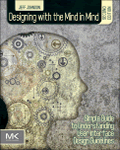 A review of
A review of
Designing with the Mind in Mind: Simple Guide to Understanding User Interface Design Guideline
by Jeff Johnson
Morgan Kauffman, 2nd edition
Have you ever needed to defend a design decision or been asked to explain why a design pattern does or does not work? If so, the second edition of Jeff Johnson’s book Designing with the Mind in Mind likely contains an explanation based on human psychology as well as relevant references.
This fourteen chapter book relates topics in psychology (such as perception), vision, attention, and memory to their corresponding human-computer interaction applications. For example, Chapter 6 “Reading is Unnatural,” addresses the role our visual system and pattern recognition play in reading. Johnson details the implications for interface design and how they relate to decisions about fonts, visual hierarchy, terminology, and the amount of text used on interfaces.
Armed with this chapter alone, a user experience professional could easily make the case for design choices such as increasing or decreasing text size or changing the style of text and background graphics.
In fact, a major strength of the book is that each chapter follows the same structure. Each describes an aspect of human psychology, relates it to human-computer interaction, and then details the associated design implications.
The references to existing user-interface design guidelines are another strength; a total of fourteen sources are listed in the “Introduction” and the “Appendix,” including the source as well as full guidelines for six of these sources. For those seeking to do follow-up research on guidelines, Designing with the Mind in Mind provides a great starting point.
In the Introduction, Johnson writes that the intended audience is
- software design and development professionals
- interaction design and human-computer interaction students, and
- software development managers.
In truth, this book would make a good everyday reference for any user experience professional. The clear writing style, comprehensive coverage of common design decisions, and the reference to human psychology that provide the theoretical support for these decisions make it a solid addition to your personal or professional library.这是对Jeff Johnson所著的《基于认知规律的设计》的书评。从心理学的角度去审视常见的设计问题。
文章全文为英文版이 책의 각 장에서는 인지심리학, 그리고 인지심리학이 HCI와 어떻게 연결되고 있는지, 그리고 관련 디자인에 제안하고 있는 함의점은 무엇인지를 서술한다. 이 책은 UX 전문가들을 위한 좋은 참고문헌 혹은 사전적 정보를 제공하고 있다.
전체 기사는 영어로만 제공됩니다.Cada capítulo deste livro descreve um aspecto da psicologia humana, como ele é relacionado com a interação homem-máquina, e as implicações de projeto associadas. É uma boa referência cotidiana para qualquer profissional de experiência do usuário.
O artigo completo está disponível somente em inglês.本書の各章には、人間の心理学的側面や、それがどのようにHCIに関係しているか、それがデザインにとってどのような意味を持つかが説明されている。UXの専門家にとって日々参照する価値のある本である。
原文は英語だけになりますCada capítulo en este libro describe un aspecto de la sicología humana, cómo se relaciona con la interacción humano-computador, y las implicancias asociadas al diseño. Sirve como una buena referencia en el día a día para cualquier profesional de la Experiencia de Usuario.
La versión completa de este artículo está sólo disponible en inglés
